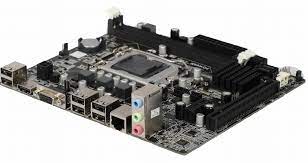Introduction:
In the dynamic world of computer hardware, the motherboard serves as the backbone, determining the capabilities and compatibility of a system. One noteworthy contender in the motherboard arena is the H61 motherboard. Designed to cater to a broad spectrum of users, the H61 motherboard has earned its reputation for reliability, efficiency, and versatility. This article explores the key features and benefits of the H61 motherboard, shedding light on why it remains a popular choice among PC enthusiasts.
H61 motherboard is intel chipset-based 2nd gen motherboard by many manufacturing Brand like Gigabyte, lapcare, Zebronics, Frontec etc.

Specifications-
| Processor support | Supports Intel® i7/i5/i3/Pentium/Celeron processors in LGA1155 | |
| Chipset | Intel® H61Chipset | |
| Memory support | 2 DDR3 dual-channel slots, Support DDR3 1066/1333/1600MHz memory | |
| LAN | Supports Realtek 8106E 10/100 Mbps | |
| Audio | Realtek 662 3xAudio Jacks for 6 channel High definition audio | |
| Back panel | 1 PS/2 mouse/keyboard port, 1 VGA port, 1HDMI port, 4 USB 2.0 ports, 1 LAN port, 3 audio jacks | |
| On-Board connectors | 1 x Front panel connector, 1 x speaker connector, 1 x Front panel audio connector (2 x 5pin), 4 x USB 2.0 ports, 4 x SATA 3Gb/s (SATAII) ports, 1 x 4pin CPU fan connector, 1 x SYS fan connector, 1 x 24-pin ATX power connector, 1 x 4-pin ATX 12V power connector, 1 x 3pin clear CMOS header |
|
| Slots | 1 PCI Express x16 slot, 1 PCI Express x1 slot | |
| Country of Origin | China |
Key Features of the H61 Motherboard:
-
Processor Compatibility:
The H61 motherboard is primarily designed for compatibility with Intel processors. Its socket, often referred to as LGA 1155, supports a range of Intel Core i3, i5, and i7 processors. This compatibility ensures users can build systems tailored to their performance needs. -
Memory Support:
The H61 motherboard typically supports DDR3 memory modules, offering a decent memory bandwidth for smooth multitasking and efficient data handling. Although DDR3 is not the latest standard, it strikes a balance between performance and cost-effectiveness. -
PCI Express Slots:
H61 motherboards generally feature PCI Express slots, providing expansion capabilities for additional components such as graphics cards, sound cards, or other PCIe devices. This versatility allows users to customize their systems based on their specific requirements. -
USB and SATA Ports:
Equipped with USB 2.0 and SATA II ports, the H61 motherboard ensures decent data transfer speeds for peripherals and storage devices. While it may not support the latest USB and SATA standards, it provides ample connectivity for everyday use. -
Integrated Graphics:
H61 motherboards often come with integrated graphics support, making them suitable for budget-friendly systems or applications where discrete graphics are not a priority. This feature can be particularly appealing for casual users and office environments. -
Compact Form Factor:
The H61 motherboard typically adheres to the Micro ATX form factor, making it suitable for compact PC builds. This form factor strikes a balance between size and expandability, offering users flexibility in designing systems for various purposes. -
Budget-Friendly Option:
One of the standout advantages of the H61 motherboard is its cost-effectiveness. Positioned as a budget-friendly option, it allows users to build reliable systems without breaking the bank, making it an attractive choice for entry-level configurations. -
Conclusion:
The H61 motherboard stands as a testament to the adaptability and resilience of computer hardware. While it may not boast the latest features, it continues to be a preferred choice for users seeking a reliable and cost-effective solution. Whether you’re assembling a budget-friendly PC or a compact system with modest performance requirements, the H61 motherboard remains a viable and dependable option in the ever-evolving landscape of motherboard technologies.
FAQs
It’s not about motherboards being “good” or “bad” for gaming. It’s about processors, graphics cards, and RAM capacity. If you combine a H61 with the most powerful processor it can support and a GTX 1660 Ti, it might function well enough to play games. The same motherboard will not work well for gaming if it is combined with a Pentium processor and integrated graphics. Motherboards aren’t good or bad for gaming because they don’t affect your performance. Tell us all the specifications of your system, and we can determine whether or not your PC is a decent gaming PC.
It’s support 2nd Gen intel core processor like Petium dual core, Core i3/i5 2nd Gen etc.
It’s socket type is LGA 1155.
It’s support upto 16gb 1600mhz ram. (8gb per slot)
It’s had usb 3.0 and 2.0 both are really good in performance.
It’s have support HDMI and vga both.
It’s Graphics card support up to NVidia 1660 ti and amd rx 580.
Branded company Gigabyte, Intel, ASUS are discontinued manufacture this product but some newcomer company ZEBRONICS, LAPCARE, FRONTECH, etc are manufacturing it and quality of the product slight lower than branded company and also efficiency of the product is lower than branded company.


Wow, fantastic weblog format! How long have you been running a blog for?
you make running a blog look easy. The total glance
of your site is excellent, as well as the content!
You can see similar here sklep online
Can you be more specific about the content of your article? After reading it, I still have some doubts. Hope you can help me.
Thank you for your sharing. I am worried that I lack creative ideas. It is your article that makes me full of hope. Thank you. But, I have a question, can you help me?